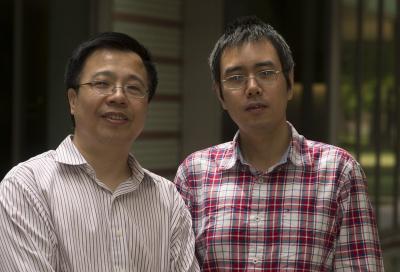HOUSTON -- (April 5, 2013) -- Rice University physicists on the hunt for theorigins of high-temperature superconductivity have published new findingsthis week about a seemingly contradictory state in which a materialsimultaneously exhibits the conflicting characteristics of both a metallicconductor and an insulator.
In a theoretical analysis this week in Physical Review Letters (PRL), Ricephysicists Qimiao Si and Rong Yu offer an explanation for a strange seriesof observations described earlier this year by researchers at the StanfordLinear Accelerator Center in Menlo Park, Calif. In those experiments,physicists used X-rays to probe the behavior of electrons in superconductingmaterials made of potassium, iron and selenium. The material becomessuperconducting at extremely cold temperatures, and the experiments revealedthat at a slightly higher temperature, the material exhibited a seeminglycontradictory electronic state in which some electrons in the iron atomsbecame frozen in place while electrons in neighboring orbitals continued tomove.
"We have proposed a unified phase diagram for the alkaline iron selenides inwhich this phase connects between the lower-temperature, superconductingphase at one extreme and a higher-temperature insulating phase at theother," said Si, Rice's Harry C. and Olga K. Wiess Professor of Physics andAstronomy.
Flowing electrons power all the world's energy grids, and a significantamount of power in those grids is lost to electrical resistance -- a kind ofelectronic friction that occurs when electrons move through metallic wires.Superconducting materials, which were discovered more than a century ago,conduct electricity without any loss of power, but they only operate atextremely cold temperatures. Since the 1980s, scientists have discovered anumber of new materials that become superconducting at temperatures that,while still cold, are above or close to the temperature of liquid nitrogen-- an important threshold for engineering applications. The hope is thatthese "high-temperature" superconductors may one day be used torevolutionize power transmission and other technologies, but physicists haveyet to develop a clear-cut understanding of how high-temperaturesuperconductors work.
In classical superconductors, frictionless conduction is achieved whenelectrons pair up in a way that allows them to flow effortlessly, withoutthe bumping and jostling that normally leads to electrical resistance.Electron pairing is uncommon because the rules of quantum mechanicstypically make electrons loners. Under normal circumstances, electrons repelone another, and the mechanism that causes them to pair up in classicalsuperconductors doesn't account for their behavior in high-temperaturesuperconductors.
Iron-based high-temperature superconductors were discovered in 2008. Si andcollaborators, including UCLA physicist Elihu Abrahams, were among the firstto propose a way in which superconductivity might arise in the iron-basedmaterials due to a phenomenon known as "correlated electron" behavior. Incorrelated-electron systems, the behavior of electrons in a material canonly be understood by viewing the electrons as a collective system ratherthan many individual objects.
Si and Yu's new paper focuses on experiments with an alkaline iron selenide,one family of materials that is included in the larger class of iron-basedsuperconductors. Prior experiments had found that alkaline iron selenidesexhibited odd electronic behaviors at temperatures above the criticaltemperature in which they transition to the superconducting state.
In the PRL paper, Si and Yu describe a new electronic state, or phase,marked by electronic traffic congestion. They show that electrons indifferent quantum states, or orbitals, react differently to the bad trafficsituation. In particular, the new phase is marked by electrons in selectedorbitals becoming locked in a place -- a phenomenon known as a Mottinsulating state.
"In a theoretical model containing several orbitals, we identified an'orbital-selective Mott phase,'" said Yu, a postdoctoral research associateat Rice. "In this phase, electrons in some orbitals behave like aninsulator, while those in the other orbitals act as a metal."
Si and Yu said they saw the first hints of the new phase in a 2011 modelthey designed to study a different family of iron-based superconductors. Inthat model, the orbital-selective Mott phase ultimately proved to beunstable, so they were somewhat surprised when the phase appeared and provedstable in the model for the alkaline iron selenides.
"This is the first time anybody has identified an orbital-selective Mottphase in any model for the iron-based superconductors," Yu said.
Si said characterizing the orbital-selective Mott phase in the alkaline ironselenides provides more clues about the fundamental origins ofsuperconductivity.
"Ultimately, our goal is to understand superconductivity and the conditionsto optimize superconductivity," Si said.
The premise is that this kind of bad traffic situation -- the contradictoryphase where electrons are in conflict as to whether they should freeze ormove -- is good for superconductivity.
"Our results provide evidence that electron correlations play a vital rolein the superconductivity of the iron-based superconductors," he said.

These are Rice University physicists Qimiao Si (left) and Rong Yu.
(Photo Credit: Jeff Fitlow/Rice University)
Source: Rice University